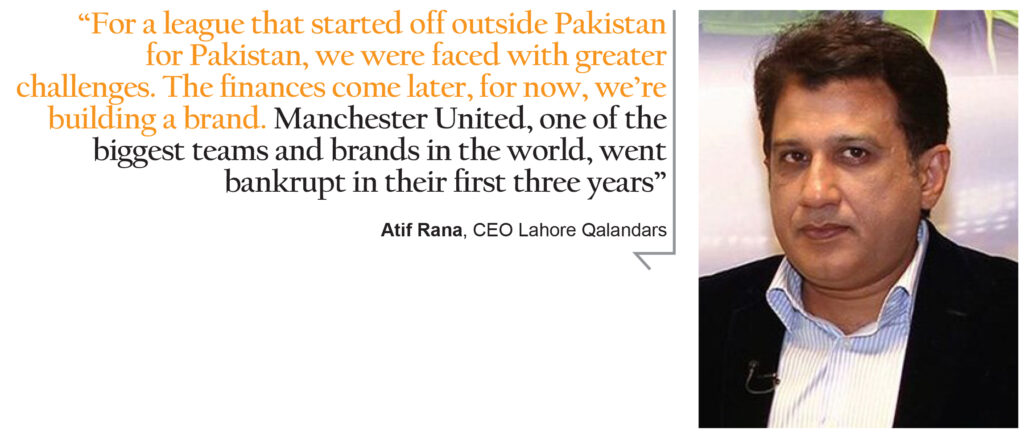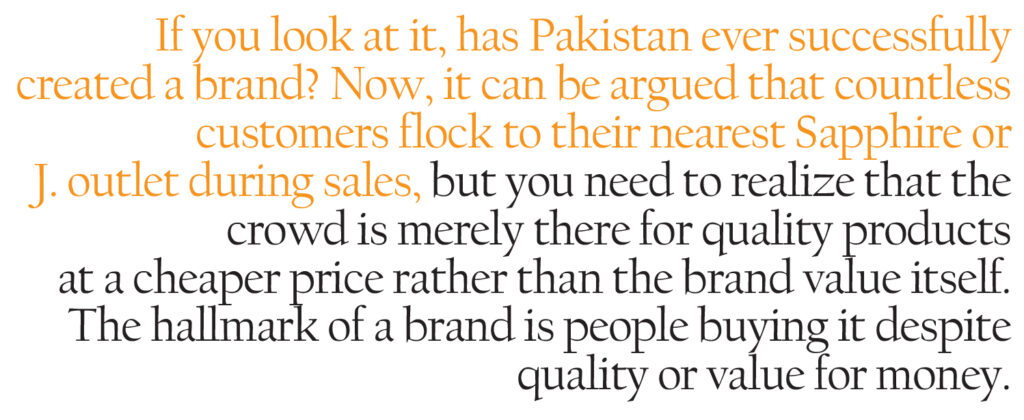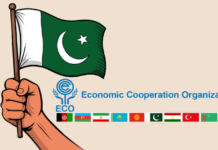When the Rana brothers bought the Lahore franchise of the fledgling Pakistan Super League (PSL) in 2015, it was a risky deal to make. Here was a tournament being hosted outside Pakistan with no guarantees of revenue for at least a few years, an equally divisible pool of income among all the teams regardless of amount invested, and high chances of failure. In addition to all this, they were signing it with the infamously fickle Pakistan Cricket Board (PCB).
All of the franchises in the tournament have largely been backed by corporate interests from Engro to Leonine Global, ARY, and Haier. And while the Lahore franchise was no exception, being owned by the Qatar Lubricants Company Limited (QALCO), its owners have been the only ones that have managed to make the tournament personal.
At the center of this is the belief of the Rana brothers, Fawad and Atif, that a team like the Lahore Qalandars has great potential to be a high-end brand. In their eyes, Lahore Qalandars has always been an opportunity to make inroads into a huge market, and establish the franchise as a recognisable Pakistani product globally and locally. A dream, in their own words, to see their team become the Manchester United of Pakistan.
To this end, the Ranas have spent more money than any other team, more than the PCB itself, promoting the PSL at a great cost, all to build the Lahore Qalandar’s brand recognition and equity. This aggressive marketing strategy, however, has been dogged by their constantly poor performance out on the field. The Ranas claim that this has not affected their ability to turn the team into a brand as has been their goal.
However, what does seem to be stopping them from getting where they want is the PCB. While the cricket board has managed to make the tournament a hit and has brought it to Pakistan completely in its last edition, its business strategy for the tournament has remained rigid and unpopular among team owners. And no matter how hard the Ranas’ Lahore Qalandars or any other team tries, turning into a brand is impossible if the PSL fails.
A breakdown of the branding
For starters, the Lahore Qalandars has taken marketing very seriously from day one, and it has been geared towards turning it into the brand. The team managed to move beyond one dimensional branding and has transcended to forming a unique identity that resonates with the people. The unique thought process behind the mere simple task of choosing a name shows that the team is in a league of its own in terms of creativity.
Whether you call it Lahore Qalandars, LQ, Dama Dam Mast Qalandar, or simply Qalandars – you are bound to be thinking what was the reason behind the name Qalandar? Could it be just quirky? Or is there some kind of hidden message or Easter egg in there?

Atif Rana, the Chief Executive Officer of the team, explained the reasoning behind the name and who it was a tribute to. “This was a tribute to our mother. She raised nine children with love and care and we wanted the name to celebrate her memory. However, we couldn’t just name it after her. She, like all mothers, was selfless and that is what a Qalandar is – selfless!” The idea behind honoring her memory was simple, “Every time someone mentions the team in good words, her memory lives on.”
In addition to this, the team is also banking on the strong connection Sufis have with this region, and that this will help them develop a unique identity that has no comparison. After all, like the Karachi Kings, the Indian Premier League has Chennai Super King, and nearly all other leagues have “Warriors”. But none of them have Qalandars, or something even close to it for that matter, and that is how the team has managed to differentiate itself through its strong alliance with the local culture.
Thus explaining the emblem, which is perhaps the greatest achievement of the Qalandars. “The name and branding is exactly what makes the Lahore Qalandars in a league of its own in terms of branding.” notes Khurram Qureshi, a global marketing consultant and the CEO and founder of Captn which happens to be Pakistan’s first emerging sports brand.
The sight of the Turkish dervish whirling in ecstasy is an internationally recognizable symbol of a softer, more mystic version of Islam. But what absolutely no one could have associated it with was cricket .
Cricket, as brilliant and magical as the game is, still reeks of a particularly English sense of sobriety and propriety. Even with the flashy, hard-hitting, party-scene form of cricket that is T20 franchise tournaments all over South Asia, whirling Sufis seems like a hard sell. But someone connected those dots somewhere, and when the maker of the Lahore Qalandars logo turned its whirling dervish into a slinky fast bowler knocking over a set of stumps, it channeled the energy of Jeff Thompson, of Shoaib Akhtar and of Andy Roberts: raw, chaotic, untethered and completely explosive.
It was, from the get-go, the most unique of all the team logos. Launch the Qalandar name with the catchiest song of the tournament (Dama Dam Mast Qalandar anyone?), Chris Gayle and Dwayne Bravo for some wild, Caribbean spirit and what you have on your hands is a franchise attracting attention. But how can one forget the lovable team owner, Fawad Rana?
It is almost as if the branding team set out to make him a symbol of the brand. In the Indian counterpart, the Indian Premier League, celebrities have been seen as team owners. While Fawad Rana was far from a celebrity before the league, he has indeed turned into a household name, so much so that he can be used as a metric to gauge the team’s popularity.
It is almost as if the team was building two brands that complement one another, Lahore Qalandars and Fawad Rana. While Lahore Qalandars was given the task to represent Lahore specifically and Pakistan as a by-product; Fawad Rana was given the task to develop a strong face against loss. For that very reason, regardless of team preference, fans of Fawad Rana grew more than other franchise owners. He became a household name which can be seen by the countless memes or the roar in the stadium when his face is on the screen.
While other leagues had celebrities owning franchises, the Pakistani crowd turned Fawad Rana into one. That, however, does not come off as a surprise. This is the same country that turned their cricket hero into a prime minister.
Are Sponsors okay with losing?
One would think that a team known for losing would have a tough time finding sponsors or retaining them. A quick look in the past shows that Lahore Qalandars was able to form the biggest partnership in PSL history with Jazz. A product of this partnership was the Jazz Rising Stars. The deal was essentially supposed to be 10 years long however, with the PSL and other leagues approaching Jazz, the company decided to renegotiate with the Qalandars. The management, however stood their ground and did not compromise on the agreed amount. As a result Jazz left the Qalandars in its third season. However, it is interesting to note that Jazz did not go on to partner with another team.
This suggests that Jazz did not ask for renegotiation due to other teams seeming more lucrative, it has more to do with the fact that Jazz just didn’t have the right budget considering the recent merger with Warid amongst other expenses. Who knows, once Jazz finds the right space in the budget it may rejoin the Qalandars.
Another interesting partnership that the Qalandars have is with Geo. This has been since day 1 of the team’s inception. When asked why Geo stuck to a team that’s performance on the field has been disappointing, Yasir Jamal the Business Unit Head of Geo Super and Geo News immediately responded with “Lahore Qalandars is the only team with a vision and plan. The team sets itself apart from others due to this plan. While winning and losing is a part of the game, the team does more than that.”

“While the plans of most teams stop with the PSL grand finale, or when they’re out of the tournament, the Lahore Qalandars work all year round. That is why their identity resonated with our brand.”
“The management not only talks, but also executes. The fact that the diamond hunting spree for talent resulted in players being found from places like Kashmir and Gilgit shows how Lahore Qalandars is all in and going beyond.”
“It is not difficult for Geo to get space of product placement on a kit or merchandise, we decided to stick with the Qalandars primarily for their continued efforts at reaching out and their role in player development.”
The differentiating factor
What differentiates the Lahore Qalandars from other teams is its year round efforts. Qureshi commented on the lack of marketing expenditure in the off season. “That is where Lahore Qalandars manages to set itself apart.”
Their grassroot outreach is, apparently, very good. They conduct regular talent hunts and have worked with raw talent that their network of coaches have scouted. They have also sent their teams to non-PSL leagues and training camps in Australia, and have discovered players such as Haris Rauf, who has recently broken into the Pakistan cricket team. If these players become international quality stars, their names and journeys will forever be associated with the grassroots campaigns of the Qalandars, which will go a long way into turning them into a brand.
This is what Jamal meant when he talked about how the franchise had a plan and vision. There sheer fact that the franchise has emerged as a market leader in terms of its branding can be seen by Multan Sultans using the same name, “Player Development Program” shows just how Lahore Qalandars were miles ahead since their inception.
Right from the first year, the Lahore Qalandars franchise organized “Jazz Rising Stars” trials in various cities across Pakistan to scout for talent in the youth. In order to train and equip this talent with skills, the franchise then arranged for the shortlisted players to travel to Australia so they could train with Sydney Thunder. The two best players would be selected to play for Lahore Qalandars. In addition, the franchise in order to empower women, will also conduct a talent hunt for women across Pakistan.
One of the things they have done is try to make the Qalandars a parent entity in Lahore at least. “In the whole world, the most-watched matches are between rivals like India and Pakistan or Australia and England, similarly the most-watched matches are between rival cities like Karachi and Lahore,” Aqib Rana tells us. This is what the team management wants to further.
“You see, no one really develops a sense of attachment to a corporate team, like the ones we had such as SNGPL, WAPDA, or the Atif Rana Cricket Club for that matter. Rivalries exist between cities, so why not extend that to ‘muhallahs’?”
For that very reason, Lahore Qalandars set up the Battle of Qalandars whereby neighborhoods in Lahore battle each other and new young talent can emerge. “Our mission is to make Bhatti the Chelsea of our league”
“Over the years, we’ve come to realize that we have the power but not the right conditions. Our franchise is helping to uplift the conditions” This is why the management has decided to replicate this model in all major cities.
The aim of this model is to engage the youth and build popularity amongst them. It comes as no surprise that the current brand ambassador for the team is their very own star player Shaheen Shah Afridi. What is interesting is that Shaheen Afridi joined the team with a $10,000 a month at the age of 17 and now has a platinum contract worth $150,000 to $170,000 a month. “What other profession in the world gives a 19-year-old a six-figure salary” asks Rana.
One would think that due to COVID-19 and the postponement of the remaining PSL matches, the franchise would be resting but that is far from reality. During the pandemic that has taken the world by storm, the team management has launched Qalandar ka Sikandar, a virtual talent hunt. “It’s not just Fawad Rana’s moustache, we’re more than that! We’re innovative.”
This connectivity with the grassroots and with people results in the team being a favorite of many. That is why the ratings were off the charts when the Qalandars started to perform this year. “As soon as we improved this season the TRPs became unimaginable. That shows how we’re in the hearts of the people.”
Besides, good publicity is publicity in itself. After all, did anyone protest over other teams losing? No! But the fans protested against the Qalandars losing, and managed to close off Liberty in Lahore. That itself backs the claim that there is love among the people and that Lahore Qalandar have infiltrated into the masses.
As a result the Qalandars have spent not only more than their counterpart teams but the PCB itself. Following the request of team owners for consideration on taxes, the PCB asked teams for their audited accounts for the first two years. The PCB, however, compiled all the accounts in the form of one email and sent it to all the teams. As a result, competing teams knew just how much each team was spending and where. However, an analysis of that shows us that Lahore Qalandars’s share of marketing and activation spend for the first two years of 40%, followed by the league itself at 37%, 8% contributed from Karachi, 7% from Islamabad, 4% each from Quetta and Peshawar. The Ranas realize that as the league grows, their team does too!
Is the ‘brand’ profitable?
But where is the money at? While the team has been able to generate revenue to cushion their investment and income, it has not reached its breakeven. Rana explained that there was no shortcut to success. “Manchester United, one of the biggest teams and brands in the world, went bankrupt in their first three years,” he says.
“For a league that started off outside Pakistan for Pakistan, we were faced with greater challenges. The finances come later. For now, we’re building a brand.” He explained that a brand is all about perception, and that is why you would not go crazy over a Louis Vuitton bag if they were worth $50 only – which served as a reminder of “Veblen goods” studied during Econ 101.

For starters, we know, the Manchester United claim is a long one. You just have to look at two things for this, what is the value of the Manchester United team, and what is the absolute total media spend in all of Pakistan? In Pakistan, before the global pandemic, that number was $750 million, of which 40% would have gone to television advertising, a number that has gone down to $430 million after the pandemic has hit. Let us assume that for some bizarre reason, one PSL team gets all of this $430 million, they would still be ten-times smaller than the $3.8 billion Manchester United.
From a quantitative standpoint, the comparison is ridiculous, yes, and Manchester United is a global entity with amazing merchandising. Moreover, as a team that keeps losing, the Lahore Qalandars are a commodity. Again, this magazine’s parent publication, Pakistan Today, has in its sports pages carried an article titled “Lahore’s performance is now hurting the PSL.” However, one can still see what the Ranas mean, Manchester United is an ideal for them to aspire to, the shining city on a hill for franchise sports. And as the PSL comes home, the idea is to make Lahore Qalandars an entity like Manchester United within Pakistan.
Atif Rana tells us that since the league itself is big, the payoff will be of equal or greater magnitude for sure, considering how the cyclical contracts awarded by the PCB are growing each year. A cycle lasts three years, with the amount for title sponsorship and broadcasting rights rising each cycle; along with gate receipts going up, there is optimism among its owners that the team will be able to enter the green territory in terms of finances.
Most important in this has been the return of the PSL and its foreign players to Pakistan in the last years. In fact, team owners have been candid about the fact that in previous editions, they made more from a couple of matches in Pakistan than they did from the rest of the tournament in the UAE. While the current coronavirus pandemic stopped the PSL in its tracks this year, before it hit, things were looking like a success.
Rana further added that during the initial seasons all matches were held in the UAE where gate receipts were not substantial. However with matches slowly moving back to the country and a number of full houses being witnessed, the team management was relaxed. “Business is always going to be a concern, but for now, what we want to focus on is the brand.”
However, a lot of the problems related to the income of the Qalandars and the other teams can be traced back to the business model adapted by the PCB which raises concerns about the sustainability of the model.
How is PCB killing the league?
In simple terms, the model is flawed! While the model made somewhat sense when the league was based in the UAE, there is a strong need to revisit some policies in wake of the league being brought back home in entirety?
- Intellectual property
Since we talked about why the shirts aren’t as commonly worn as football jerseys it is important to note that while the rules regarding copyright infringement aren’t too strong in Pakistan, the intellectual rights to the shirts and branding belong to PCB, while the ownership remains with the teams. This means that if any team owner wants to take action against businesses that are illegally making team shirts, they cannot do so themselves. They have to push the PCB to take legal action. This resulted in no major legal claim being made so far. It is also pertinent to note that due to this and the lack of respect for intellectual property, the league owners are able to generate dismal revenue from the sale of their merchandise during season and off season.
- Division of Central Pool
We are Profit after all, and sooner than later we have to talk about money. Essentially one would think that the return on investment should be based on the investment. However, in PSL’s case it is the opposite. The yearly income generated from the central pool is divided equally amongst teams. Central Pool consists of the income generated from the title sponsor, in-stadium branding, and broadcasting rights. One could argue that a team that costs more based on the initial investment should have a share of the central pool in accordance to the ratio. That, however, is not the case. Owing to which the team that benefits the most is Quetta Gladiators, while the team that may never be able to break-even is the Multan Sultans that were a later addition to the PSL lineup.
- Competing against sponsors
The PSL itself competes against teams for sponsors. This is further amplified by the fact that Broadcasting rights and in-stadium branding is both handed over to a third party consortium. This props up the question to brands – would you rather invest in sponsoring the PSL brand and getting coverage for all the matches, or just restrict yourself to a team. The fact that this is done through a consortium results in all the juice from the market absorbed leaving little space for the franchises to cash in.
- Lack of accountability
While there were talks of the PCB handing over the responsibility of the PSL to a third party in the form of a corporate entity. Basically, the investors in the franchises are the ones that have pumped money into the league. However, it is them that have been facing the brunt of the loses. Every entity other than them can be seen as making some sort of gain, whereas the investor here is being penalized. With the PCB not answerable to the franchises in entirety, the league owners find it hard to get their demands met or their concerns addressed, considering how the PCB is a government entity.
- Example of potential loss of revenue
Ignoring the cost on the exchequer, the PCB has set up offices within the Qaddafi Stadium facing the ground. This is unprecedented around the world. During PSL season, these offices that offer the best view of the ground are turned into boxes to view the match. When the matches are held in UAE VVIP boxes such as these go for more than 1 to 1.5 million rupees. However, the PCB uses this as a relationship building exercise. As a result, there is a loss of potential revenue considering how these seats are not sold, but merely used as gifts. Another question comes to mind on where the officials work from during match season but that is an entirely different debate.
- The right to gate receipts
If you compare the PSL with the IPL, one significant difference in the business model is that the franchise earns gate receipts on home matches and also pay for the expenses. Considering how the team puts in efforts to bring its fans to watch a match, they should be able to gain off of it. However, the PCB decided to distribute gate receipts equally amongst teams for all matches. This made sense when matches were in the UAE and the crowd turnout was negligible. However with the league returning back home, the model needs to be revisited.
- Perpetuity of team ownership
Each team has purchased rights for 10 years. However, if the trajectory of losses continues, one has to question whether the league can continue. After the agreed time passes, franchise owners have the first right of refusal. By then the “brand” value of their team is bound to go up. A simple example could be of how Multan Sultan entered the market at a valuation of 6.3 million. Using that example, one can only assume what a franchise will cost after the 10th edition of PSL. However, despite the brand worth it has accumulated over the years, the real revenue that is coming in is dismal. Which means team owners may not reinvest in their teams, nor will anyone else be willing to. That basically kills the franchises and the league. One could say a simple solution is brand perpetuity, but the primary concern remains on the need of making the league profitable.
The bottom line
While every business decision usually surrounds the topline, this one seems to be far from it. Up until the previous season none of the teams emerged profitable regardless of how many matches they won or lost. Is this because the brand PSL itself is larger than what the market can meet? Does the market not have the ability to absorb it?
It comes as a question whether for the sake of Lahore’s success the league can persist. Considering how the Ranas draw inspiration from Manchester United, a quick look at how the team is highly leveraged and pumps that money back into their team’s development. The question is, how long will the Rana’s be able to continue with their investment? Will the team suffer at the hands of the dismal revenue? Will they not be able to afford expensive and top tier players? How long can they continue with their player development programs? Is this investment doomed from the very beginning? One can only question and hope that the PCB isn’t killing Pakistan’s biggest brand, the PSL – and the subsequent brands it has in the form of franchises. Afterall, how long can the Ranas of the cricket world smile through the pain of losing their money?
Additional Reporting: Babar Khan Javed
Comments are closed.




















I love lahore
Lahore Qalandars is by far the most relatable PSL brand. And that is not just because of the NTHP program & exciting new players such as Rauf, Dilbar, Shaheen etc. but rather due to the lengths they go to look after their own. Rehabilitation stories of Raza Hasan & Imran Nazir are heartwarming to say the least & speak of the compassion this think tank is driven by. 5th season into the PSL & thankfully for most of us fans, they have finally found winning ways too. This is a squad that thrives on momentum & becomes hard to pin down when on song. In the years to come, you’ll see this group go from strength to strength for the simple reason that the mechanism in place helps in churning out raw talent that can be refined at their own High Performance Centre. Plus the vision to have strategic partnerships with Bigh Bash teams in Australia is only likely to help these young guns get a well rounded experience.
– Proud Fan.